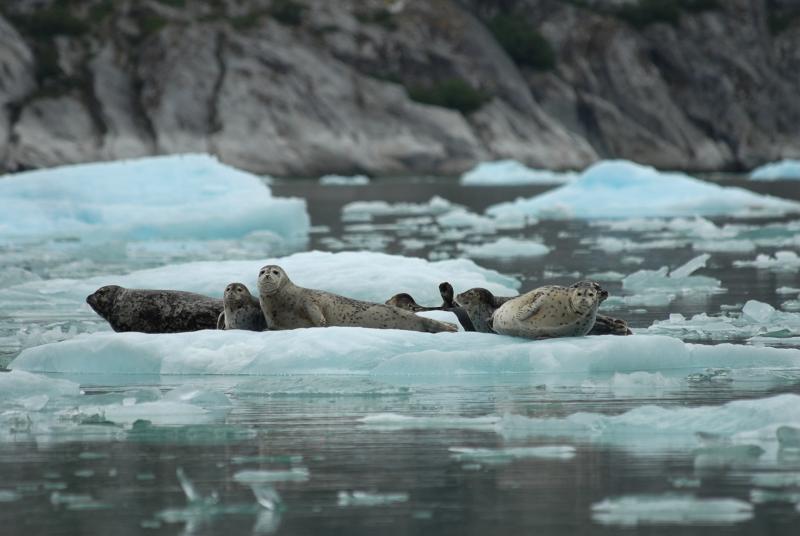Starting around mid-May each year, there is a spike in the number of inhabitants in the icy waters of Alaska’s glacial fjords. After about 10 months of pregnancy, female harbor seals begin giving birth to their pups. While most populations of harbor seals give birth on land, some seals in Alaska rely on ice floes in glacial fjords for giving birth and rearing their pups. These ice floes have broken off nearby glaciers, a process known as “glacial calving.” They provide a platform for harbor seals to rest, molt, and care for their young. To protect these seals, we established voluntary vessel approach guidelines that reduce disturbance while allowing glacier and wildlife viewing.
In addition to harbor seals, glacial fjords also attract a lot of tourists. Alaska's tourism industry has seen steady growth in recent years. Cruise passenger numbers have risen from an average of 1.3 million in 2019 to 1.7 million in 2023. From late spring through fall, vessels visit these scenic fjords almost daily, ranging in size from single-person kayaks to cruise ships carrying thousands of passengers.
Researchers at the NOAA Fisheries Alaska Fisheries Science Center have spent several decades studying the impacts of vessel disturbance on harbor seal behavior in glacial fjords. General guidelines suggest vessels remain 100 yards from marine mammals. In the early 2010s, the researchers recognized that these guidelines were not sufficient to prevent disturbance to seals resting and nursing their pups on ice floes. When approached too closely, seals abandon their resting spots. Pups flushed from ice floes are submerged in cold water, which can increase energy use and stress levels. Repeated exposure to such disturbances can negatively impact their health and even threaten their survival.
We introduced the voluntary vessel approach guidelines for harbor seals in glacial fjords in 2015. They include area-specific measures for Tracy Arm and Disenchantment Bay in Southeast Alaska. The guidelines were established after considering public feedback regarding the management practices needed to protect the important function of tidewater glacial habitats.
How can vessels avoid disturbing harbor seals?
Any vessel, from a small kayak to a massive cruise ship, visiting glacial fjords has the potential to disturb harbor seals on ice floes. The following guidelines are strongly recommended for all vessels at any time of the year:
- Maintain 500 yards (0.25 miles) from seals hauled out on ice floes—watch for seals both when arriving and departing the fjord
- Minimize wake, abrupt changes in course, and loud noises (e.g., loudspeakers, ice collisions); seals can react to sound from loudspeakers that can carry for miles
- Avoid thick ice wherever possible, which is prime habitat for rearing seal pups—where there is ice, there will be seals, and they can see you even if you can’t see them
- Visit glacial fjords earlier or later in the day, because peak numbers of seal haul out around midday
For vessels visiting South Sawyer Glacier in Tracy Arm Fjord between May 15 and June 30, we strongly recommend:
- Avoid “streams” of ice starting at Tern Point. “Streams” are clusters of ice emanating from the glacier along one shoreline or the other.
- Stop about 1,250 yards (0.75 miles) from the glacier face to avoid higher seal densities.
For vessels visiting Hubbard Glacier in Disenchantment Bay between May 15 and June 30, we strongly recommend:
- Restrict travel to the eastern half of the bay within 2,640 yards (1.5 miles) of the shoreline
- Stay farther than 2,640 yards (1.5 miles) from Hubbard Glacier — higher densities of seals tend to be closer to the glacier face
- Stay south of an east-west line at the northern tip of Egg Island when ice is thick
Harbor Seals in Alaska
Harbor seals are one of the most common marine mammals found along the East and West Coasts of the United States. In Alaska, NOAA Fisheries has identified 12 stocks of harbor seals. The Alaskan stocks range from Southeast Alaska out to the Pribilof Islands in the middle of the Bering Sea. For additional information on the different stocks of harbor seals in Alaska, read the most recent Stock Assessment Report. Harbor seals in Alaska are not considered threatened or endangered under the Endangered Species Act, but are protected from harassment by the Marine Mammal Protection Act.








